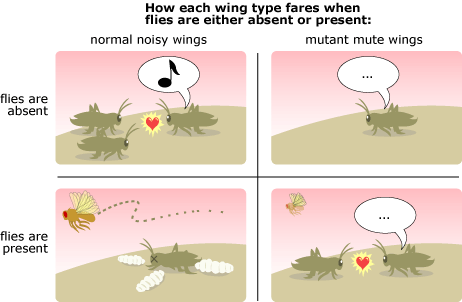Table of Contents
Group 1
Sex, death and silence in Hawaiian crickets
Wiki site of the practical exercise of the III Southern-Summer School on Mathematical Biology.
Here you will find the exercise assignment and the group's products.
If you are a group member login to edit this page, create new pages from it, and upload files.
Final Presentation
Group
- Anderson Aires, Eduardo; Federal University of Bahia, Brazil
- Badali, Matthew/Anthony; University of Toronto, Department of Physics, Canada
- Fonseca Parra, Eulises Alejandro; Federal University of Pernambuco, Department of Physics
- von Hartenthal, Francisco Westphalen; Federal University of Paraná, Graduate School in Ecology, Brazil
- Montero Serra, Ignasi; University of Barcelona, Department of Ecology, Spain
- Ribeiro, Giulia Magri; University of Sao Paulo, Zoology Department, Brazil
Assistants
- Flávia Marquitti
- Juliana Berbert
- Bernardo Niebuhr
Assignment
Males of many crickets species use calling songs as sexual signals. Females locate and select singing males even in the dark of night, and can be very choosy in their mating preferences. This is indeed the norm in many populations of the Pacific field cricket, Teleogryllus oceanicus, but not in Hawaii, where there is a deadly enemy, the fly Ormia ochracea. This fly is a parasitoid that uses the cricket's song to find and lay larvae on the singing males. The larvae then find their way inside the bodies of the unfortunate singers and feast on their internal tissues, eventually killing the host.
In 2006 Marlene Zuk and collaborators documented the rapid spread of a silent male morph in a population of Teleogryllus oceanicus in Kauai Island, Hawaii 1). The morph is called 'flatwings', as it lacks the wing structures used to produce songs. The change is caused by a single gene in the sexual chromosome of males 2).
Flatwing males escape from the parasitoid, but also are not found by females. Instead, they have a 'satellite' sexual behavior – they attempt to mate with females that are attracted by calling males. Currently about 90% of the male crickets in Kauai were of the flatwing morph. This huge proportion of silent satellites rely on the few remaining singing males to reproduce.
Questions
This is a well-documented case of persistence of a maladaptative sexual character due to parasitoid pressure. The genetic, evolutionary and behavioral patterns are far more explored than the demographic and/or population genetics dynamics of the system.
The basic question is to propose a mathematical model that portrays this dynamic in a simple but biologically realistic way. Given that, you can investigate the dynamic behavior of the model, as well as check which values of the parameters ensue persistence of both morphs and the parasitoid in the long run. Further well-grounded insights are welcome.
Hints
- A key feature of this system is the inheritance mechanism of the flatwing gene.
- Another key information is the degree of specialization of the parasitoid.
- The published literature about the system provides plenty of useful biological information. It was mainly produced by a single research group, so it is coherent and well circumscribed, and can be fully appreciated.



